 The hope, of course, is that they don’t. Given a higher level of activity on the part of middle-age Americans and seniors who practice a more active and involved lifestyle than their counterparts of a generation ago, the potential for revision surgery when an artificial hip or knee fails well before its intended lifespan can prove much more than a mere inconvenience.
The hope, of course, is that they don’t. Given a higher level of activity on the part of middle-age Americans and seniors who practice a more active and involved lifestyle than their counterparts of a generation ago, the potential for revision surgery when an artificial hip or knee fails well before its intended lifespan can prove much more than a mere inconvenience.Given that more Americans are working longer and pushing retirement farther off, revision surgery can further eat into a job and income. A subsequent observation not often articulated is that a revision surgery is often much more involved and subject to more potential complications than the initial procedure. This can result in more time to recover, further eating into an active lifestyle, and for some, the need to earn a living.
It has been widely reported that the proposed $2.5 billion settlement with regard to the DePuy metal-on-metal artificial hips manufactured and marketed by the Johnson & Johnson unit, would be worth about $250,000 in settlement dollars to the average plaintiff in the class, before legal fees.
The compensation for pain and suffering - including J&J’s offer to compensate plaintiffs for medical bills and other related costs - does not speak to the frustration felt by plaintiffs suffering from metal toxicity due to the absorption of minute particles generated from the all-metal artificial hips. Metal toxicity can lead to a dearth of health problems. And yet, according to the New York Times report, many plaintiffs found it challenging to convince their doctors there was a legitimate problem.
At the same time, Johnson & Johnson was reportedly denying there was a problem, further exasperating hip replacement patients.
The building blocks of a Perfect Hip and Knee Replacement Storm
The proposed J&J settlement announced last fall with regard to the failed DePuy devices could be the tip of the iceberg in what could be mushrooming into a perfect storm of Hip and Knee Replacement Implant Failure. That’s because Americans are continuing to age, with baby boomers - much more active in middle age than a previous generation - are beginning to enter retirement. That creates a huge market for replacement hips and replacement knees, a market about which manufacturers are all too aware.
The other underlying factor building the Perfect Hip and Knee Replacement Storm is the much-maligned 510(k) clearance observed by the US Food and Drug Administration (FDA) that allows for a more rapid pathway to market for a new or updated device substantially similar to a device already available.
When replacement hips and knees were first envisioned decades ago, there was no precedent. Thus, the FDA required manufacturers to undertake costly clinical trials to ensure the devices were safe and effective within a small collection of representative patients, before the devices were made available to the wider population. For the consumer, such a protocol for new devices and new medicines afforded protection from needless pain and suffering from a device poorly designed and not properly vetted.
For the manufacturer, however, it represents a massive delay in finally reaching a market, with millions spent over the interim. The FDA 510(k) clearance was a way to shorten the wait and reduce costs by allowing design updates to devices already on the market to take a pass on pre-market clinical trials and reach the market sooner.
READ MORE HIP AND KNEE REPLACEMENT LEGAL NEWS
Critics, however, say this turns the wider population into unwitting guinea pigs.
The thousands upon thousands of plaintiffs having filed a Hip Replacement Lawsuit - and similar patients pursuing a Knee Replacement Lawsuit - suggest the 510(k) strategy was flawed. And yet well-heeled manufacturers earning additional revenue from the 510(k) clearance protocol appear to view yet another phone call from yet another Hip Replacement Lawyer as just another transaction. It’s the cost of doing business.
For the Hip and Knee Replacement Implant Failure patient, the cost is that much greater. As baby boomers continue to age and the market continues to grow and become even more lucrative, the stakes keep getting higher…
